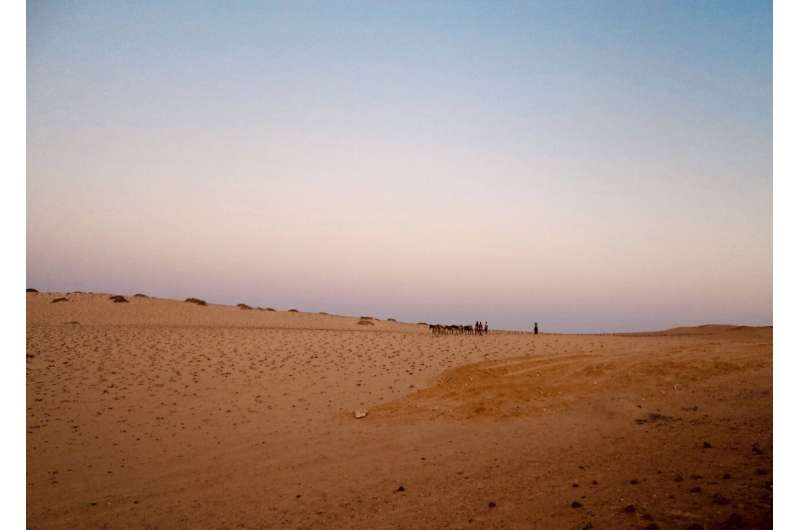This article has been reviewed according to Science X's editorial process and policies. Editors have highlighted the following attributes while ensuring the content's credibility:
fact-checked
peer-reviewed publication
trusted source
proofread
The deep genetic structure of Africa reveals unique ancestry of inhabitants of the Angolan Namib

Africa is the birthplace of modern humans and the continent with the highest level of genetic diversity. While ancient DNA studies are revealing some aspects of the genetic structure of Africa before the spread of food production, issues concerning DNA preservation have limited the insights from ancient DNA.
Hoping to find clues in modern populations, researchers from a Portuguese-Angolan TwinLab ventured into the Angolan Namib desert—a remote, multi-ethnic region where different traditions met. The work is published in the journal Science Advances.
"We were able to locate groups which were thought to have disappeared more than 50 years ago," says Jorge Rocha, a population geneticist from Centro de Investigação em Biodiversidade e Recursos Genéticos (CIBIO, University of Porto) who led the fieldwork, together with Angolan anthropologists Samuel and Teresa Aço from the Centro de Estudos do Deserto (CEDO).
Among the communities the team encountered are the Kwepe, a pastoral group who used to speak a language known as Kwadi. "Kwadi was a click-language that shared a common ancestor with the Khoe languages spoken by foragers and herders across southern Africa," explains Anne-Maria Fehn, a linguist from CIBIO who participated in the fieldwork and was able to interview what may well be the last two speakers of Kwadi.
"Khoe-Kwadi languages have been linked to a prehistoric migration of eastern African pastoralists," adds Rocha, whose research focuses on southern African population history.
In addition, the team contacted Bantu-speaking groups that are part of the dominant pastoral tradition of southwest Africa, as well as marginalized groups whose origins have been associated with a foraging tradition, distinct from that of the neighboring Kalahari peoples, and whose original language was supposedly lost.
-

Kuvale settlement in Virei, Namibe province of Angola. Credit: Sandra Oliveira -

The last two speakers of Kwadi. Credit: Jorge Rocha
Modern DNA research can complement ancient DNA studies
The team's new study shows that the inhabitants of the Angolan Namib are quite divergent from other modern populations but also highly structured among themselves.
"In agreement with our previous studies on the maternally-inherited DNA, most genome-wide diversity segregates according to socio-economic status. A lot of our efforts were placed in understanding how much of this local variation and global excentricity was caused by genetic drift—a random process that disproportionally affects small populations—and by admixture from vanished populations," says Sandra Oliveira, a researcher at the University of Bern in Switzerland who worked with these populations during her Ph.D. and post-doc studies with Rocha and Mark Stoneking at CIBIO and the Max Planck Institute for Evolutionary Anthropology (MPI-EVA) in Leipzig, Germany.
The team demonstrated that besides the high impact of genetic drift, which contributed to differences among neighboring groups of different socio-economic status, the descendants of Kwadi speakers and the marginalized communities of the Namib Desert retain a unique Pre-Bantu ancestry that is only found in populations from the Namib desert.
Mark Stoneking, who contributed to the earliest genome-wide studies on southern African foragers and participated in this study says, "Previous studies revealed that foragers from the Kalahari desert descend from an ancestral population who was the first to split from all other extant humans. Our results consistently place the newly identified ancestry within the same ancestral lineage but suggest that the Namib-related ancestry diverged from all other southern African ancestries, followed by a split of northern and southern Kalahari ancestries."
With this new information, the researchers could reconstruct the fine-scale histories of contact emerging from the migration of Khoe-Kwadi-speaking pastoralists and Bantu-speaking farmers into southern Africa. Moreover, the study demonstrates that modern DNA research targeting understudied regions of high ethnolinguistic diversity can complement ancient DNA studies in probing the deep genetic structure of the African continent.
More information: Sandra Oliveira et al, Genome wide variation in the Angolan Namib desert reveals unique Pre-Bantu ancestry, Science Advances (2023). DOI: 10.1126/sciadv.adh3822. www.science.org/doi/10.1126/sciadv.adh3822
Journal information: Science Advances
Provided by Max Planck Society




















